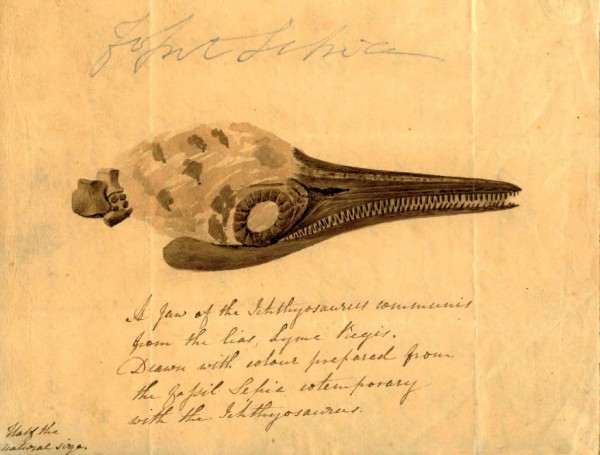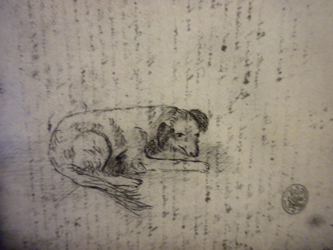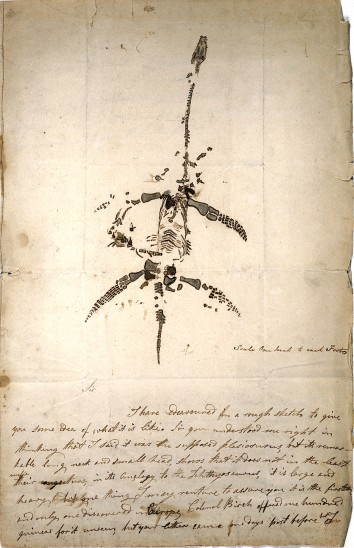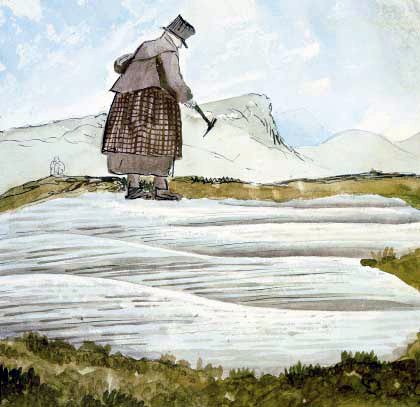Il Naturalista del Mese di Ottobre e’ Mary Anning, una paleontologa fai-da-te, nata nel 1799 in una famiglia di classe operaia a Lyme Regis, nell’Inghilterra del Sud. Suo padre era un ebanista di poco successo che vendeva fossili trovati nei ricchi strati argillosi noti come “Blue Lias” sulle spiagge di Lyme Regis, fitti di fossili marini del Giurassico. Tutti i giorni passava ore a scrutare le rocce, insegnando a Joseph e Mary (unici due figli sopravvissuti di dieci nascite) l’arte del cacciatore di fossili, che poi venivano venduti da una bancarella davanti al negozio di mobili come “curiosita”: le “dita di diavolo” (belemniti), le “pietre di serpente” (ammoniti) e le “vertebacche” (vertebre di vari animali) erano i fossili piu venduti durante l’infanzia di Mary.
Mary divenne famosa subito ad una giovane età quando, da bebe durante un’evento nel suo villaggio, un fulmine colpì l’albero sotto il quale lei e tre donne adulte si erano messe al riparo. Le tre donne morirono mentre Mary sopravvisse, entrando immediatamente nelle leggende locali e facendo sì che tutti attribuirono a quell’incidente la sua mente brillante e curiosità. 
A soli 12 anni lei e il suo fratello trovarono forse il loro fossile piu conosciuto: il primo ritrovamento fossile di un Ittiosauro che venne inizialmente chiamato con una sfilza di nomi creativi: da “coccodrillo” a “mostro” a “drago marino” a “pesce lucertola”. Suo fratello Joseph trovò il cranio per caso, mentre è stato grazie alla costanza di Mary che venne successivamente trovato il resto dell’animale mostruoso. Uno scheletro completo fu estratto, pulito diligentemente e venduto ad un collezionista locale poco dopo.
 Mary era una cacciatrice di fossili curiosa e devota, che sceglieva i momenti migliori per la “caccia” di curiosità da vendere. Solitamente preferiva uscire durante la bassa marea, dopo temporali in cui il vento, la pioggia e le onde avevano reso più friabile gli strati di roccia e lo sgretolamento scopriva nuovi fossili. In quei tempi la caccia ai fossili era molto pericolosa, come Mary stessa potè sperimentare con la morte precoce di suo padre Richard, dopo una brutta caduta dalla scogliera, e la morte del suo cane Tray, un terrier bianco e nero compagno costante delle sue ricerche, durante una frana quasi uccise anche Mary. l’ttiosauro fu seguito da molteplici notevoli scoperte, come per esempio i primi due Plesiosauri ad essere trovati e il primo esemplare Brittannico di uno Pterosauro, tra altri “mostri” (il termine dinosauro, “terribile lucertola”, fu coniato solamente nel 1841 da Sir Richard Owen). La sua curiosità fu la chiave in molte scoperte basate sull’osservazione. Durante lo studio di alcuni bezoar, nome con il quale venivano chiamati i coproliti a quel tempo, notò pezzi di osso, scaglie ed altri resti organici dentro ai fossili stessi. Quando trovo dei bezoar contenuti nello scheletro di un fossile piu grande, giunse alla conclusione che questi erano in effetti le feci di creature preistoriche; condivise i suoi pensieri con William Buckland, professore di Geologia ad Oxford, che poi pubblicò un articolo nel quale presentò le sue scoperte e riconosse pubblicamente l’importanza di Mary nella risoluzione del mistero dei bezoar. Fu ancora grazie alle sue doti da osservatrice che scoprì che le famosa “dita del diavolo”, o belemniti, erano in realta un tipo diverso (specie estinta) di seppia. Raggiunse questa conclusione dopo aver trovato una sacco di inchiostro in un belemnite fossile e averlo legato concettualmente alla sacca di inchiostro di seppie moderne, che era abituata a sezionare per migliorare la sua conoscenza di anatomia. La sua amica e collega paleontologa Elizabeth Philpot riuscì a rivivificare l’inchiostro (e usarlo in alcuni suoi schizzi). Anche se le sue scoperte erano effettivamente notevoli, essere una donna di classe operaia ed essere nata in una famiglia di dissidenti religiosi era decisamente un enorme ostacolo durante l’era Vittoriana.
Mary era una cacciatrice di fossili curiosa e devota, che sceglieva i momenti migliori per la “caccia” di curiosità da vendere. Solitamente preferiva uscire durante la bassa marea, dopo temporali in cui il vento, la pioggia e le onde avevano reso più friabile gli strati di roccia e lo sgretolamento scopriva nuovi fossili. In quei tempi la caccia ai fossili era molto pericolosa, come Mary stessa potè sperimentare con la morte precoce di suo padre Richard, dopo una brutta caduta dalla scogliera, e la morte del suo cane Tray, un terrier bianco e nero compagno costante delle sue ricerche, durante una frana quasi uccise anche Mary. l’ttiosauro fu seguito da molteplici notevoli scoperte, come per esempio i primi due Plesiosauri ad essere trovati e il primo esemplare Brittannico di uno Pterosauro, tra altri “mostri” (il termine dinosauro, “terribile lucertola”, fu coniato solamente nel 1841 da Sir Richard Owen). La sua curiosità fu la chiave in molte scoperte basate sull’osservazione. Durante lo studio di alcuni bezoar, nome con il quale venivano chiamati i coproliti a quel tempo, notò pezzi di osso, scaglie ed altri resti organici dentro ai fossili stessi. Quando trovo dei bezoar contenuti nello scheletro di un fossile piu grande, giunse alla conclusione che questi erano in effetti le feci di creature preistoriche; condivise i suoi pensieri con William Buckland, professore di Geologia ad Oxford, che poi pubblicò un articolo nel quale presentò le sue scoperte e riconosse pubblicamente l’importanza di Mary nella risoluzione del mistero dei bezoar. Fu ancora grazie alle sue doti da osservatrice che scoprì che le famosa “dita del diavolo”, o belemniti, erano in realta un tipo diverso (specie estinta) di seppia. Raggiunse questa conclusione dopo aver trovato una sacco di inchiostro in un belemnite fossile e averlo legato concettualmente alla sacca di inchiostro di seppie moderne, che era abituata a sezionare per migliorare la sua conoscenza di anatomia. La sua amica e collega paleontologa Elizabeth Philpot riuscì a rivivificare l’inchiostro (e usarlo in alcuni suoi schizzi). Anche se le sue scoperte erano effettivamente notevoli, essere una donna di classe operaia ed essere nata in una famiglia di dissidenti religiosi era decisamente un enorme ostacolo durante l’era Vittoriana.

 La ragione principale per la raccolta di fossili era l’importo economico e la maggior parte dei suoi fossili venivano venduti, poi rivenduti o presentati come scoperte personali da prominenti uomini scientifici che probabilmente non avevano mai messo piede sulle scivolose scogliere di Dorset. Con il passare degli anni questo costante scavalcamento dei suoi meriti mise in Mary una amarezza permanente verso il sesso maschile e il mondo scientifico in generale. Durante la sua vita, tuttavia, fu riconosciuta ufficiosamente come esperta e colleghi andavano da lei per consigli, pensieri, aiuto ed esperienza. Quando attraversò un brutto periodo finanziario il suo amico Colonello Birch mise all’asta la maggior parte della sua collezione di fossili (comprati da Mary) e le diede il ricavato. Nel 1847 Mary Anning morì di cancro al seno. Fu apprezzata in vita senza essere pubblicamente accreditata per l’incredibile progresso che fece fare al mondo della Paleontologia. Fu, tuttavia, largamente dimenticata dopo la sua morte. Nel 1865 Charles Dickens scrisse “la figlia del carpentiere si è guadagnata un nome, e si merita di esserselo guadagnato”. Si dice sia la protagonista del celebre scioglilingua Inglese, creato nel 1908 da Terry Sullivan che inizia “She sells sea shells on the sea shore….”. Nel 2010 la Royal Society stilò una lista di dieci donne Brittanniche che ebbero la più grande influenza sulla storia della scienza. Mary Anning fu inclusa.
La ragione principale per la raccolta di fossili era l’importo economico e la maggior parte dei suoi fossili venivano venduti, poi rivenduti o presentati come scoperte personali da prominenti uomini scientifici che probabilmente non avevano mai messo piede sulle scivolose scogliere di Dorset. Con il passare degli anni questo costante scavalcamento dei suoi meriti mise in Mary una amarezza permanente verso il sesso maschile e il mondo scientifico in generale. Durante la sua vita, tuttavia, fu riconosciuta ufficiosamente come esperta e colleghi andavano da lei per consigli, pensieri, aiuto ed esperienza. Quando attraversò un brutto periodo finanziario il suo amico Colonello Birch mise all’asta la maggior parte della sua collezione di fossili (comprati da Mary) e le diede il ricavato. Nel 1847 Mary Anning morì di cancro al seno. Fu apprezzata in vita senza essere pubblicamente accreditata per l’incredibile progresso che fece fare al mondo della Paleontologia. Fu, tuttavia, largamente dimenticata dopo la sua morte. Nel 1865 Charles Dickens scrisse “la figlia del carpentiere si è guadagnata un nome, e si merita di esserselo guadagnato”. Si dice sia la protagonista del celebre scioglilingua Inglese, creato nel 1908 da Terry Sullivan che inizia “She sells sea shells on the sea shore….”. Nel 2010 la Royal Society stilò una lista di dieci donne Brittanniche che ebbero la più grande influenza sulla storia della scienza. Mary Anning fu inclusa.
This month’s Naturalist is Mary Anning, a self-made palaeontologist born to a poor family in 1799 in Lyme Regis, Dorset. Her father sold fossils as an aside to his main activity, cabinet-making, and raised his children (two survived out of ten that were born), Joseph and Mary, on the shores of Lyme Regis, looking for fossils on the rich and ever yielding Jurassic marine fossil beds known as Blue Lias. Her family had a stall outside her father’s cabinet shop that sold “curios” to tourists, presenting them with “devil’s fingers” (belemnites), “snake stones” (ammonites) and “verteberries” (various animal vertebrae). Mary first became famous as an infant when, during a village event, a bolt of lightning hit a tree under which she and three adult women were standing. All three women died whereas she survived and was inserted into years and years of local storytelling. People claimed that it was that incident that made her a “bright and curious” child. It was as a 12 year old that she and her brother found their maybe most renowned fossil: the first ever found fossil of an Ichthyosaur that was called an assorted array of names, from crocodile to monster to sea dragon to fish lizard. Her brother Joseph found the skull by chance, but it was thanks to young Mary’s research that a few months later she found the rest of the “dragon”. A complete skeleton was extracted, diligently cleaned and sold to a local collector shortly thereafter. Mary was a curious, dedicated fossil hunter, carefully choosing what she felt were the best moments to look for new curios. She’d go out on the shores of Lyme Regis during low tide, preferably after a storms, when the wind, rain and waves had made the rock layers weak and prone to crumbling and sliding. Fossil hunting in those days was very dangerous, as her personal experience violently taught her with the death of Richard Anning, her father, after a fall from the cliffs and that of her constant companion, Tray, a black and white terrier, in a landslide that nearly killed Mary, too. The Ichthyosaur was followed by more remarkable discoveries, such as the first two Plesiosaurs to come to light and the first British specimen of a pterosaur, among other “monsters” (the term dinosaur, or “terrible lizard”, was coined by Sir Richard Own in 1841). Her curiosity was key in many observational discoveries. Whilst studying bezoars, as coprolites were known at the time, she noticed tiny
maybe most renowned fossil: the first ever found fossil of an Ichthyosaur that was called an assorted array of names, from crocodile to monster to sea dragon to fish lizard. Her brother Joseph found the skull by chance, but it was thanks to young Mary’s research that a few months later she found the rest of the “dragon”. A complete skeleton was extracted, diligently cleaned and sold to a local collector shortly thereafter. Mary was a curious, dedicated fossil hunter, carefully choosing what she felt were the best moments to look for new curios. She’d go out on the shores of Lyme Regis during low tide, preferably after a storms, when the wind, rain and waves had made the rock layers weak and prone to crumbling and sliding. Fossil hunting in those days was very dangerous, as her personal experience violently taught her with the death of Richard Anning, her father, after a fall from the cliffs and that of her constant companion, Tray, a black and white terrier, in a landslide that nearly killed Mary, too. The Ichthyosaur was followed by more remarkable discoveries, such as the first two Plesiosaurs to come to light and the first British specimen of a pterosaur, among other “monsters” (the term dinosaur, or “terrible lizard”, was coined by Sir Richard Own in 1841). Her curiosity was key in many observational discoveries. Whilst studying bezoars, as coprolites were known at the time, she noticed tiny  pieces of bone, scales and other organic matter contained inside the fossils. When she found some inside a large fossil skeleton, she reached the conclusion that bezoars were actually faeces of prehistoric creatures; she shared her thoughts with William Buckland, who lectured on Geology in Oxford, and who would then publish a paper in which he showed her findings and, in a way, acknowledged her importance in this amazing discovery. It was also with her observational skills that she found out that the famous “devil’s fingers”, or belemnites, were actually a different kind (extinct species) of cuttlefish. She reached this conclusion after finding a fossilised ink sac in one of the fossils and linking it to the ink sacs that she had observed in fresh cuttlefish that she was used to dissecting to better her anatomical knowledge. Her friend and fellow palaeontologist Elizabeth Philpot managed to revivify the fossilised ink (and use it in some of her drawings). Although her discoveries were indeed remarkable, being a working class woman from a religiously dissenting family during the Victorian age was definitely a personal setback. The main reason for her fossil collecting was to earn money, so her fossils were usually bought, then sold for a higher price or directly presented as the finds of prominent scientific men that probably had never even set foot on the slippery Dorset cliffs. As the years went by, this bypassing of her merits made Mary sour towards men (she never married) and the scientific community in general. She was never accepted in the Geological Society of London and she never published a scientific article. She was, however, acknowledged by many
pieces of bone, scales and other organic matter contained inside the fossils. When she found some inside a large fossil skeleton, she reached the conclusion that bezoars were actually faeces of prehistoric creatures; she shared her thoughts with William Buckland, who lectured on Geology in Oxford, and who would then publish a paper in which he showed her findings and, in a way, acknowledged her importance in this amazing discovery. It was also with her observational skills that she found out that the famous “devil’s fingers”, or belemnites, were actually a different kind (extinct species) of cuttlefish. She reached this conclusion after finding a fossilised ink sac in one of the fossils and linking it to the ink sacs that she had observed in fresh cuttlefish that she was used to dissecting to better her anatomical knowledge. Her friend and fellow palaeontologist Elizabeth Philpot managed to revivify the fossilised ink (and use it in some of her drawings). Although her discoveries were indeed remarkable, being a working class woman from a religiously dissenting family during the Victorian age was definitely a personal setback. The main reason for her fossil collecting was to earn money, so her fossils were usually bought, then sold for a higher price or directly presented as the finds of prominent scientific men that probably had never even set foot on the slippery Dorset cliffs. As the years went by, this bypassing of her merits made Mary sour towards men (she never married) and the scientific community in general. She was never accepted in the Geological Society of London and she never published a scientific article. She was, however, acknowledged by many 
 geologists and palaeontologists of the time who came to her for advice, help, insights and experience. During a financial crisis one of her friends, Colonel Birch, auctioned most the fossils in his possession (which he had bought from Mary) and gave her the proceeds. Mary Anning died in 1847 from breast cancer. She was appreciated in life without being publicly accredited for the incredible progress she made in the paleontological world. She was, however, largely forgotten after her death. In 1865 Charles Dickens wrote “the carpenter’s daughter has won a name for herself, and deserved to win it.” She also seems to be the protagonist in the 1908 tongue twister “She sells sea shells on the sea shore….” by Terry Sullivan. In 2010 the Royal Society made a list of the ten British women that had most influenced the history of science. Mary Anning was there.
geologists and palaeontologists of the time who came to her for advice, help, insights and experience. During a financial crisis one of her friends, Colonel Birch, auctioned most the fossils in his possession (which he had bought from Mary) and gave her the proceeds. Mary Anning died in 1847 from breast cancer. She was appreciated in life without being publicly accredited for the incredible progress she made in the paleontological world. She was, however, largely forgotten after her death. In 1865 Charles Dickens wrote “the carpenter’s daughter has won a name for herself, and deserved to win it.” She also seems to be the protagonist in the 1908 tongue twister “She sells sea shells on the sea shore….” by Terry Sullivan. In 2010 the Royal Society made a list of the ten British women that had most influenced the history of science. Mary Anning was there.
leggi la recensione del libro su Mary Anning
segui il blog di Margherita Bandini qui
